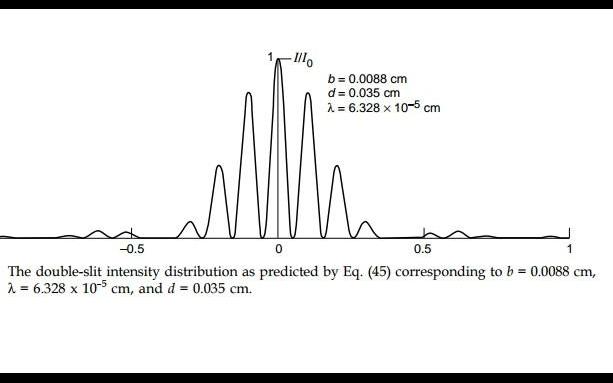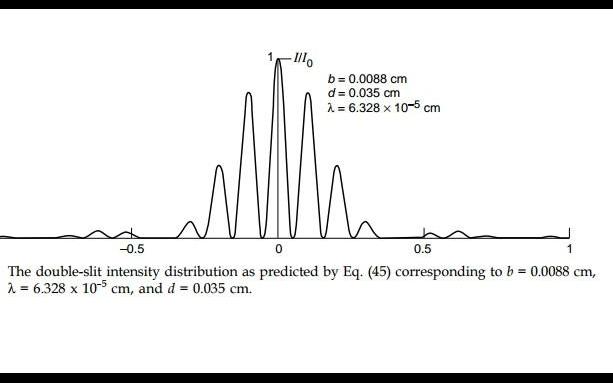Time management is very much important in IIT JAM. The eduncle test series for IIT JAM Mathematical Statistics helped me a lot in this portion. I am very thankful to the test series I bought from eduncle.
Nilanjan Bhowmick AIR 3, CSIR NET (Earth Science)Susobhan Ghosh posted an Question
- IIT JAM
- Physics (PH)
How n upto 8 it is considering as n is all the integers?
- 0 Likes
- 7 Comments
- 0 Shares
-
Isha lohan 1
![best-answer]()
Remember this formula that first missing order occurs at nearest integer to =d/b.
-
Isha lohan 1
This uses the concept of missing order. I'll explain you the missing order. You see that question is asking no of INTERFERENCE minima between two DIFFRACTION minima. So there should be some finite no of minimas here. We knoe that 'n' means the n th no of minima and we take n=1,2,3,4... Theoretical we have infinite no of maxima and minimas, but here it is asked that no of minimas between two diffraction minimas. So here we need to know that, if maxima of interference coincide with minima of diffraction we get finally a minima there, so we call it a missing order, From the calculations of theta after practicing many questions one will find out that this first time missing order occur at nth maxima, where n=d/b In your ques, you do 8.8/7 gives 7.95 approx 8 so 8 on positive x axis and 8 on negative x axis. Remember this formula that first missing order occurs at nearest integer to =d/b.
![cropped3368664692801534115.jpg]()
-
Isha lohan 1
This uses the concept of missing order. I'll explain you the missing order. You see that question is asking no of INTERFERENCE minima between two DIFFRACTION minima. So there should be some finite no of minimas here. We knoe that 'n' means the n th no of minima and we take n=1,2,3,4... Theoretical we have infinite no of maxima and minimas, but here it is asked that no of minimas between two diffraction minimas. So here we need to know that, if maxima of interference coincide with minima of diffraction we get finally a minima there, so we call it a missing order, From the calculations of theta after practicing many questions one will find out that this first time missing order occur at nth maxima, where n=d/b In your ques, you do 8.8/7 gives 7.95 approx 8 so 8 on positive x axis and 8 on negative x axis. Remember this formula that first missing order occurs at nearest integer to =d/b.
![cropped3368664692801534115.jpg]()
-
Isha lohan 1
This uses the concept of missing order. I'll explain you the missing order. You see that question is asking no of INTERFERENCE minima between two DIFFRACTION minima. So there should be some finite no of minimas here. We knoe that 'n' means the n th no of minima and we take n=1,2,3,4... Theoretical we have infinite no of maxima and minimas, but here it is asked that no of minimas between two diffraction minimas. So here we need to know that, if maxima of interference coincide with minima of diffraction we get finally a minima there, so we call it a missing order, From the calculations of theta after practicing many questions one will find out that this first time missing order occur at nth maxima, where n=d/b In your ques, you do 8.8/7 gives 7.95 approx 8 so 8 on positive x axis and 8 on negative x axis. Remember this formula that first missing order occurs at nearest integer to =d/b.
![cropped3368664692801534115.jpg]()
![eduncle-logo-app]()
in the question it has been said numbers of interference minimal between the 1st min of diffraction but if it would had been said find number of interference maximas in between 1st min of diffraction then also in that case 8?
![eduncle-logo-app]()
yess
-
Isha lohan 1
This uses the concept of missing order. I'll explain you the missing order. You see that question is asking no of INTERFERENCE minima between two DIFFRACTION minima. So there should be some finite no of minimas here. We knoe that 'n' means the n th no of minima and we take n=1,2,3,4... Theoretical we have infinite no of maxima and minimas, but here it is asked that no of minimas between two diffraction minimas. So here we need to know that, if maxima of interference coincide with minima of diffraction we get finally a minima there, so we call it a missing order, From the calculations of theta after practicing many questions one will find out that this first time missing order occur at nth maxima, where n=d/b In your ques, you do 8.8/7 gives 7.95 approx 8 so 8 on positive x axis and 8 on negative x axis. Remember this formula that first missing order occurs at nearest integer to =d/b.
![cropped3368664692801534115.jpg]()
Do You Want Better RANK in Your Exam?
Start Your Preparations with Eduncle’s FREE Study Material
- Updated Syllabus, Paper Pattern & Full Exam Details
- Sample Theory of Most Important Topic
- Model Test Paper with Detailed Solutions
- Last 5 Years Question Papers & Answers
Sign Up to Download FREE Study Material Worth Rs. 500/-























Isha lohan 1 Best Answer
This uses the concept of missing order. I'll explain you the missing order. You see that question is asking no of INTERFERENCE minima between two DIFFRACTION minima. So there should be some finite no of minimas here. We knoe that 'n' means the n th no of minima and we take n=1,2,3,4... Theoretical we have infinite no of maxima and minimas, but here it is asked that no of minimas between two diffraction minimas. So here we need to know that, if maxima of interference coincide with minima of diffraction we get finally a minima there, so we call it a missing order, From the calculations of theta after practicing many questions one will find out that this first time missing order occur at nth maxima, where n=d/b In your ques, you do 8.8/7 gives 7.95 approx 8 so 8 on positive x axis and 8 on negative x axis. Remember this formula that first missing order occurs at nearest integer to =d/b.
it seems due to some technical problem. answer dot 5,6 times repeated.
but we need to find missing order is the missing order represents the minimum case of diffraction in double slit? as told number of interference between min of diffraction and how you got d/b formula?
does diffraction minimum means always the missing order? in double slit exp or nth slit exp as you took the missing order for 1st diffraction minima
no diffraction minima always does not mean missing order. it occurs in double slit.
ask if any further doubt
yes In double slit only mean to say not in single slit that diffraction minimas will cause the missing order? and the formula how did you get?
well, actually my teacher taught this during optics course, but you can derive it by yourself if you analyse the formulas and conditions for interference maxima and diffraction minima in double slit. you put n=1,23,..in both condition and find out the thetas corresponding to them, you will find at particular value of n, the thetas in both diffraction and interference minima will come out to be same. and at that theta you will get your missing order. Here. Below. I derived it for you. Look.
see. hope you get it.
when our ratio of d and b is equal to any of the mth minima of diffraction, then this condition is satisfied. if d becomes equal to b then m=1. this will be same as single slit situation
heartfull of thanks for your effort actually you cleared my pin point doubts 👌
you are pursuing msc from where can you say?
Yes. Pursuing msc
geophysics?
yes master's
great 👍👌